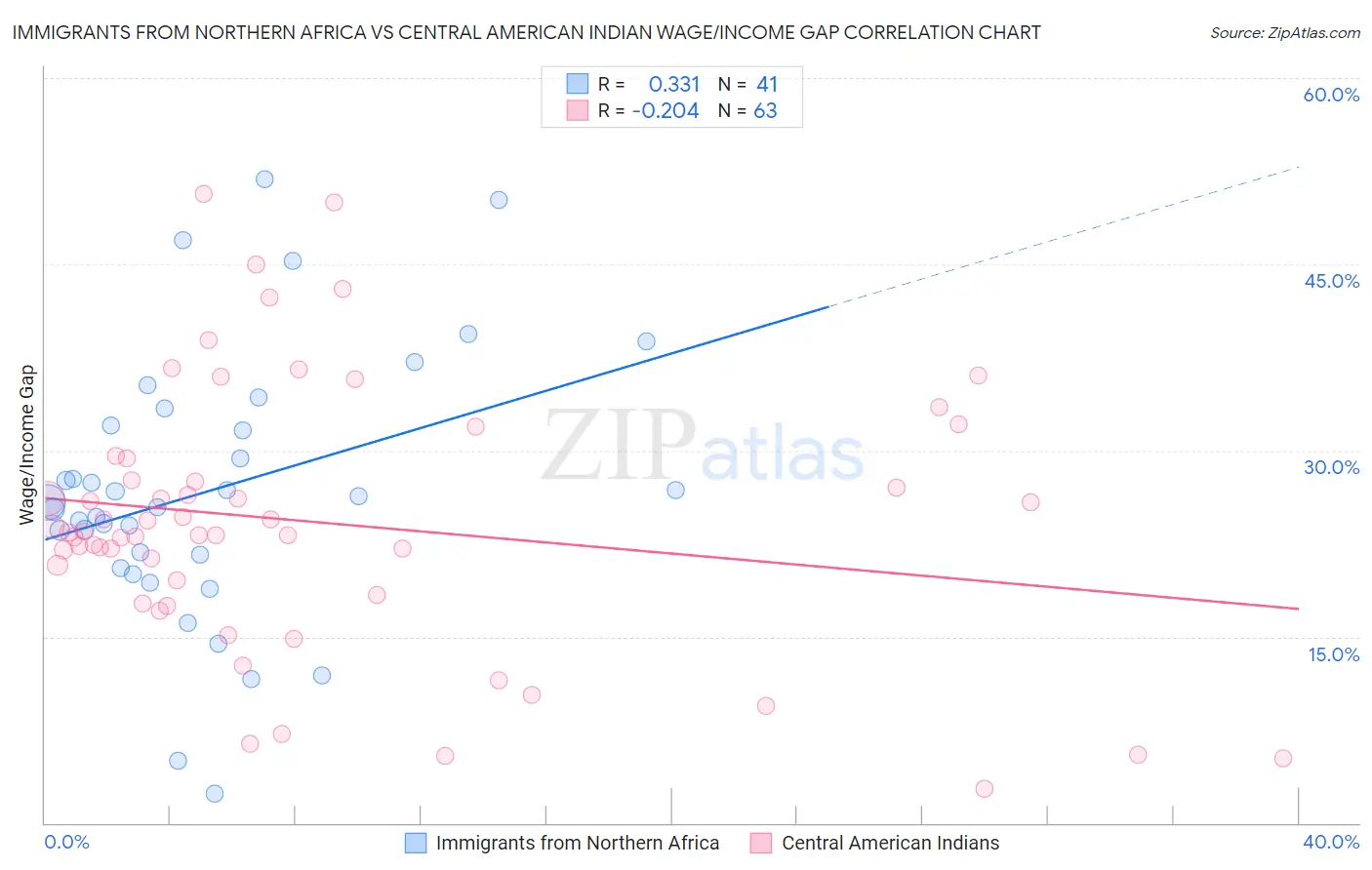Immigrants from Northern Africa vs Central American Indian Wage/Income Gap
COMPARE
Immigrants from Northern Africa
Central American Indian
Wage/Income Gap
Wage/Income Gap Comparison
Immigrants from Northern Africa
Central American Indians
25.2%
WAGE/INCOME GAP
78.1/ 100
METRIC RATING
154th/ 347
METRIC RANK
22.7%
WAGE/INCOME GAP
99.9/ 100
METRIC RATING
66th/ 347
METRIC RANK
Immigrants from Northern Africa vs Central American Indian Wage/Income Gap Correlation Chart
The statistical analysis conducted on geographies consisting of 321,071,721 people shows a mild positive correlation between the proportion of Immigrants from Northern Africa and wage/income gap percentage in the United States with a correlation coefficient (R) of 0.331 and weighted average of 25.2%. Similarly, the statistical analysis conducted on geographies consisting of 325,982,547 people shows a weak negative correlation between the proportion of Central American Indians and wage/income gap percentage in the United States with a correlation coefficient (R) of -0.204 and weighted average of 22.7%, a difference of 11.3%.

Wage/Income Gap Correlation Summary
| Measurement | Immigrants from Northern Africa | Central American Indian |
| Minimum | 2.3% | 2.8% |
| Maximum | 51.9% | 50.6% |
| Range | 49.5% | 47.9% |
| Mean | 26.8% | 24.2% |
| Median | 25.8% | 23.4% |
| Interquartile 25% (IQ1) | 21.1% | 18.4% |
| Interquartile 75% (IQ3) | 32.7% | 29.3% |
| Interquartile Range (IQR) | 11.6% | 11.0% |
| Standard Deviation (Sample) | 10.8% | 10.6% |
| Standard Deviation (Population) | 10.7% | 10.5% |
Similar Demographics by Wage/Income Gap
Demographics Similar to Immigrants from Northern Africa by Wage/Income Gap
In terms of wage/income gap, the demographic groups most similar to Immigrants from Northern Africa are Blackfeet (25.2%, a difference of 0.010%), Immigrants from Vietnam (25.2%, a difference of 0.040%), Immigrants from Mexico (25.3%, a difference of 0.16%), Costa Rican (25.3%, a difference of 0.22%), and Uruguayan (25.2%, a difference of 0.33%).
| Demographics | Rating | Rank | Wage/Income Gap |
| Malaysians | 84.9 /100 | #147 | Excellent 25.0% |
| Iroquois | 83.9 /100 | #148 | Excellent 25.1% |
| Immigrants | Peru | 82.6 /100 | #149 | Excellent 25.1% |
| Immigrants | Immigrants | 82.3 /100 | #150 | Excellent 25.1% |
| Taiwanese | 81.6 /100 | #151 | Excellent 25.1% |
| Uruguayans | 81.3 /100 | #152 | Excellent 25.2% |
| Blackfeet | 78.1 /100 | #153 | Good 25.2% |
| Immigrants | Northern Africa | 78.1 /100 | #154 | Good 25.2% |
| Immigrants | Vietnam | 77.7 /100 | #155 | Good 25.2% |
| Immigrants | Mexico | 76.4 /100 | #156 | Good 25.3% |
| Costa Ricans | 75.8 /100 | #157 | Good 25.3% |
| Immigrants | Zimbabwe | 73.7 /100 | #158 | Good 25.3% |
| Puget Sound Salish | 73.0 /100 | #159 | Good 25.3% |
| French American Indians | 72.5 /100 | #160 | Good 25.4% |
| Albanians | 69.4 /100 | #161 | Good 25.4% |
Demographics Similar to Central American Indians by Wage/Income Gap
In terms of wage/income gap, the demographic groups most similar to Central American Indians are Menominee (22.7%, a difference of 0.17%), Immigrants from Nigeria (22.7%, a difference of 0.18%), Indonesian (22.7%, a difference of 0.21%), Guatemalan (22.6%, a difference of 0.24%), and Immigrants from Uzbekistan (22.7%, a difference of 0.32%).
| Demographics | Rating | Rank | Wage/Income Gap |
| Navajo | 100.0 /100 | #59 | Exceptional 22.4% |
| Immigrants | Middle Africa | 100.0 /100 | #60 | Exceptional 22.4% |
| Immigrants | Fiji | 100.0 /100 | #61 | Exceptional 22.4% |
| Immigrants | Guatemala | 100.0 /100 | #62 | Exceptional 22.5% |
| Immigrants | Ecuador | 100.0 /100 | #63 | Exceptional 22.5% |
| Spanish American Indians | 100.0 /100 | #64 | Exceptional 22.5% |
| Guatemalans | 99.9 /100 | #65 | Exceptional 22.6% |
| Central American Indians | 99.9 /100 | #66 | Exceptional 22.7% |
| Menominee | 99.9 /100 | #67 | Exceptional 22.7% |
| Immigrants | Nigeria | 99.9 /100 | #68 | Exceptional 22.7% |
| Indonesians | 99.9 /100 | #69 | Exceptional 22.7% |
| Immigrants | Uzbekistan | 99.9 /100 | #70 | Exceptional 22.7% |
| Immigrants | El Salvador | 99.9 /100 | #71 | Exceptional 22.8% |
| Sub-Saharan Africans | 99.9 /100 | #72 | Exceptional 22.8% |
| Immigrants | Eastern Africa | 99.9 /100 | #73 | Exceptional 22.8% |